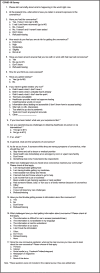The Deaf Community's Experiences Navigating COVID-19 Pandemic Information
- PMID: 34213997
- PMCID: PMC8241230
- DOI: 10.3928/24748307-20210503-01
The Deaf Community's Experiences Navigating COVID-19 Pandemic Information
Abstract
Background: Users of American Sign Language (ASL) who are deaf often face barriers receiving health information, contributing to significant gaps in health knowledge and health literacy. To reduce the spread of coronavirus disease 2019 (COVID-19) and its risk to the public, the government and health care providers have encouraged social distancing, use of face masks, hand hygiene, and quarantines. Unfortunately, COVID-19 information has rarely been available in ASL, which puts the deaf community at a disadvantage for accessing reliable COVID-19 information.
Objective: This study's primary objective was to compare COVID-19-related information access between participants who are deaf and participants who are hearing.
Methods: The study included 104 adults who are deaf and 74 adults who are hearing who had participated in a prior health literacy study. Surveys were conducted between April and July 2020 via video conference, smartphone apps, or phone calls. COVID-19 data were linked with preexisting data on demographic and health literacy data as measured by the Newest Vital Sign (NVS) and the ASL-NVS.
Key results: Neither group of participants differed in their ability to identify COVID-19 symptoms. Adults who are deaf were 4.7 times more likely to report difficulty accessing COVID-19 information (p = .011), yet reported using more preventive strategies overall. Simultaneously, adults who are deaf had 60% lower odds of staying home and calling their doctor versus seeking health care immediately or doing something else compared with participants who are hearing if they suspected that they had COVID-19 (p = .020).
Conclusions: Additional education on recommended COVID-19 management and guidance on accessible health care navigation strategies are needed for the deaf community and health care providers. Public health officials should ensure that public service announcements are accessible to all audiences and should connect with trusted agents within the deaf community to help disseminate health information online in ASL through their social media channels. [HLRP: Health Literacy Research and Practice. 2021;5(2):e162-e170.] Plain Language Summary: Compared to participants who are hearing, a higher portion of participants who are deaf reported challenges with accessing, understanding, and trusting COVID-19 information. Although respondents who are deaf had similar knowledge of symptoms compared to participants who are hearing, they used more prevention strategies and were more likely to plan immediate care for suspected symptoms. Improved guidance on COVID-19 management and health care navigation accessible to the deaf community is needed.
Similar articles
-
Health Literacy and Difficulty Accessing Information About the COVID-19 Pandemic Among Parents Who Are Deaf and Hard-of-Hearing.Health Lit Res Pract. 2022 Oct;6(4):e310-e315. doi: 10.3928/24748307-20221116-01. Epub 2022 Dec 6. Health Lit Res Pract. 2022. PMID: 36475981 Free PMC article.
-
Assessing Health Literacy in Deaf American Sign Language Users.J Health Commun. 2015;20 Suppl 2(0 2):92-100. doi: 10.1080/10810730.2015.1066468. J Health Commun. 2015. PMID: 26513036 Free PMC article.
-
Perceptions of cardiovascular health in an underserved community of deaf adults using American Sign Language.Disabil Health J. 2011 Jul;4(3):192-7. doi: 10.1016/j.dhjo.2011.04.001. Epub 2011 May 14. Disabil Health J. 2011. PMID: 21723526 Free PMC article.
-
Video Relay Interpretation and Overcoming Barriers in Health Care for Deaf Users: Scoping Review.J Med Internet Res. 2022 Jun 9;24(6):e32439. doi: 10.2196/32439. J Med Internet Res. 2022. PMID: 35679099 Free PMC article.
-
Improving Cancer Literacy for the Deaf Using Deaf-Tailored Educational Interventions: a Review of the Literature.J Cancer Educ. 2018 Aug;33(4):737-748. doi: 10.1007/s13187-017-1216-5. J Cancer Educ. 2018. PMID: 28452025 Review.
Cited by
-
COVID-19 Information-Seeking, Health Literacy, and Worry and Anxiety During the Early Stage of the Pandemic in Switzerland: A Cross-Sectional Study.Int J Public Health. 2022 Aug 9;67:1604717. doi: 10.3389/ijph.2022.1604717. eCollection 2022. Int J Public Health. 2022. PMID: 36016963 Free PMC article.
-
Understanding the impacts of the COVID-19 response measures on Deaf adults in Cape Town.Afr J Disabil. 2024 Jun 19;13:1371. doi: 10.4102/ajod.v13i0.1371. eCollection 2024. Afr J Disabil. 2024. PMID: 38962748 Free PMC article.
-
How sign language expertise can influence the effects of face masks on non-linguistic characteristics.Cogn Res Princ Implic. 2022 Jun 23;7(1):53. doi: 10.1186/s41235-022-00405-6. Cogn Res Princ Implic. 2022. PMID: 35737184 Free PMC article.
-
Health Literacy and Difficulty Accessing Information About the COVID-19 Pandemic Among Parents Who Are Deaf and Hard-of-Hearing.Health Lit Res Pract. 2022 Oct;6(4):e310-e315. doi: 10.3928/24748307-20221116-01. Epub 2022 Dec 6. Health Lit Res Pract. 2022. PMID: 36475981 Free PMC article.
-
Evaluation of disparities in hospitalisation outcomes for deaf and hard of hearing patients with COVID-19: a multistate analysis of statewide inpatient databases from Florida, Maryland, New York and Washington.BMJ Open. 2025 Jan 21;15(1):e089470. doi: 10.1136/bmjopen-2024-089470. BMJ Open. 2025. PMID: 39842928 Free PMC article.
References
-
- Association of Medical Professionals with Hearing Losses . (2020). COVID-19 resource list. https://www.amphl.org/blog/2020/3/15/covid-19-resource-list
MeSH terms
Grants and funding
LinkOut - more resources
Full Text Sources
Medical
Miscellaneous


